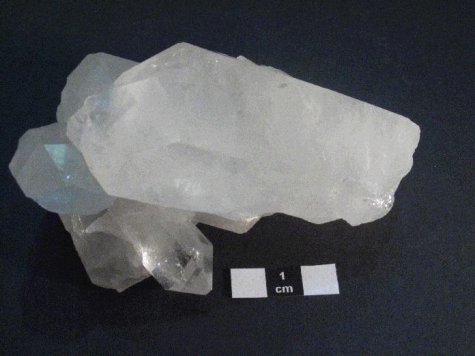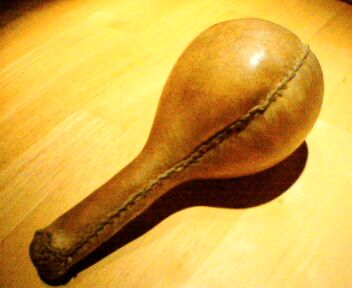The time-keeping crystal
Text: Jaak Kikas, UT Institute of Physics
Photos: Jaak Kikas and Wikimedia
Translation: Liis from forum
Photo 1. Rock crystal is a variety of quartz characterised by large crystals.
The American West. The Indians of the Uncompahgre Ute tribe have gathered for a night ritual. One detail in their activity is interesting for us: from the rattles, made of thin buffalo skin and held by the men, a light glows in rhythm with the rattling. Where does it come from? It has to do with tribo-luminescence: the light arises from the knocking and rubbing of quartz pieces in the rattles against each other (tribo = rub, wear). The ritual of the Ute Indians is probably the only practical use of this unusual phenomenon (If even this activity, meant to achieve the good will of the spirits, can be considered practical?). But there have been, and are, much more important uses of quartz that will be discussed below.
Photo 2. The triboluminescent quartz-containing rattle of the Uncompahgre Ute indians.
Structurally quartz is crystalline silicon dioxide, SiO2. In nature this is one of the most abundant minerals (quartz sand!), which occurs in many varieties. Quartz in the shape of large, colourless crystals is known as rock crystal; the largest naturally occurring quartz crystals may have dimensions of up to several meters and weigh up to hundreds of kilos. Triboluminescence is characteristic for milky quartz. Methods of growing quartz crystals artificially have been successfully developed.
Photo 3. Triboluminescent milky quartz (flash rock).
Photo 4. In Estonia pure quartz sand has been mined from the Piusa sandpits.
Quartz has been known and used by humans already since very ancient times. Quartz minerals were widely used materials for making tools for work, hunting and war in the Stone Age, even in Estonia. One such “stone workshop”, with an age of about 7000 years, was discovered by archaeologists in 2004 in Siksälä Kerikumägi near Misso in Võrumaa.
Photo 5. Archaeological excavations at Siksälä Kerikumägi. 7000 years ago the inhabitants of that time made tools out of quartz.
But with a completely new role quartz is an important high-technology material even to-day. For our society, that “ticks” ever faster, the correct time and the exact running of clocks is ever-increasingly important. And quartz makes its unique contribution here. A characteristic of quarts is the piezo-electric effect – when a quartz crystal is deformed an electrical voltage is created between its surfaces. And the other way about – an electrical voltage applied to the crystal produces a deformation of the crystal. Each quartz crystal has a characteristic and exact vibration frequency, determined by the shape and dimensions of the crystal; these oscillations are stable and minimally damped. The mechanical oscillations are accompanied by electrical oscillations – so for instance the electrical signal synchronising the operation of all elements in a computer is generated. Consoles made of piezo-electrical quartz are used in scanning probe microscopy for the ultraprecise positioning of the probe tip.
Quartz is useful not only for measuring millionths of parts of seconds, but also thousands of years. In a simple but effective experiment this can be demonstrated and seen. For this it is only needed to heat a cooking range in a dark room until it is possible to detect the beginning of a faint red glow with eyes adapted to the darkness. Then a pinch of sand is thrown onto the range. In a few moments the cooking range glitters like a starry sky – each grain of sand “ignites” briefly and then dies down again. This is thermoluminescence. High-energy particles, liberated through ages in the natural radioactive decay, destroy the crystal structure of the quartz, causing defects in it. This is stored energy which can be released as light when the crystal is heated. Heating removes the defects and sets the thermoluminescence clock to zero. The clock then again starts to “reload” with time. Thus the intensity of the thermoluminescence is a measure of the time since the latest heating of the crystal. An example of this is for instance the firing of ceramics which provides archaeologists with an opportunity to determine the age of ceramics. The clock can also be zeroed by a long period in sunlight, a fact of interest for geologists dealing with river sediments. (Because of this the sand for the experiment described above should come from a source protected from light.)
The structure of quartz can retain memories of even more ancient and mighty events – the shock waves accompanying the fall of giant meteors (extremely high pressure) leave specific traces in the quartz crystal which can be detected by microscopic studies. Quartz grains deformed in this way can be found all over the world in a layer that is also rich in the rare element iridium. These two facts together point to the iridium-rich giant meteor that hit the Yucatan peninsula 65 million years ago, leaving behind the 180 km diameter Chicxulub crater (see Google Maps). How this event may have contributed to the extinction of the dinosaurs is an object of continued controversy among scientists. But the most recent shock-deformed quartz is already the work of man. In 1962 a ground-level nuclear experiment, known as Storax Sedan, was carried out in the Nevada testing ground (see Google Maps). This was a nuclear experiment that left behind the greatest environmental pollution in the USA, and on the test site metamorphs of quartz deformed by shock waves have been discovered.
Quartz is useful not only for measuring millionths of parts of seconds, but also thousands of years. In a simple but effective experiment this can be demonstrated and seen. For this it is only needed to heat a cooking range in a dark room until it is possible to detect the beginning of a faint red glow with eyes adapted to the darkness. Then a pinch of sand is thrown onto the range. In a few moments the cooking range glitters like a starry sky – each grain of sand “ignites” briefly and then dies down again. This is thermoluminescence. High-energy particles, liberated through ages in the natural radioactive decay, destroy the crystal structure of the quartz, causing defects in it. This is stored energy which can be released as light when the crystal is heated. Heating removes the defects and sets the thermoluminescence clock to zero. The clock then again starts to “reload” with time. Thus the intensity of the thermoluminescence is a measure of the time since the latest heating of the crystal. An example of this is for instance the firing of ceramics which provides archaeologists with an opportunity to determine the age of ceramics. The clock can also be zeroed by a long period in sunlight, a fact of interest for geologists dealing with river sediments. (Because of this the sand for the experiment described above should come from a source protected from light.)
The structure of quartz can retain memories of even more ancient and mighty events – the shock waves accompanying the fall of giant meteors (extremely high pressure) leave specific traces in the quartz crystal which can be detected by microscopic studies. Quartz grains deformed in this way can be found all over the world in a layer that is also rich in the rare element iridium. These two facts together point to the iridium-rich giant meteor that hit the Yucatan peninsula 65 million years ago, leaving behind the 180 km diameter Chicxulub crater (see Google Maps). How this event may have contributed to the extinction of the dinosaurs is an object of continued controversy among scientists. But the most recent shock-deformed quartz is already the work of man. In 1962 a ground-level nuclear experiment, known as Storax Sedan, was carried out in the Nevada testing ground (see Google Maps). This was a nuclear experiment that left behind the greatest environmental pollution in the USA, and on the test site metamorphs of quartz deformed by shock waves have been discovered.
Photo 6. Storax Sedan nuclear test.














